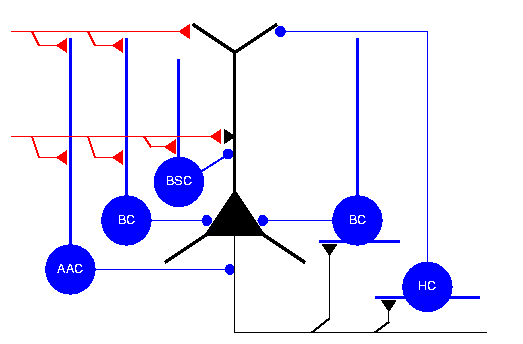General
Projects
Cortical Dynamics and Associative Memory
In an EPSRC-funded collaboration with Dr Stuart Cobb (University of Glasgow) I am studying the dynamics and functionality of the hippocampal microcircuit (illustrated below, redrawn from Paulsen and Moser, TINS 21:273-278, 1998). The emphasis is on how the dynamic control structures provided by the variety of inhibitory interneurons may allow hippocampal regions CA1 and CA3 to function as associative memories with dynamic phasing between storage and recall modes.
Overview [top]
Our brains consist of electrical circuits formed by the interconnection of vast numbers of cells called neurons. In the cortex the dominant neuronal type is the pyramidal cell, which is the main information processor in our neuronal networks. The pyramidal cells are surrounded by a smaller number but much more diverse population of interneurons that form connections locally with pyramidal cells and themselves. By building detailed computer models of brain circuits we will explore how these microcircuits of interneurons control the flow of information through pyramidal cells. In particular we will investigate how the interneurons can influence whether the pyramidal cells are processing information on the basis of previously stored knowledge or are learning from new experiences. Knowledge is stored in the strengths of connections between neurons and learning depends on how plastic or changeable these synaptic (connection) strengths are. The field of artificial neural networks (ANNs) has demonstrated that information processing devices can be built using this paradigm. However, current ANN models use much simpler circuitry and cell types than our brains. We hope to further our understanding of the operation of the complex microcircuitry found in cortex and how it acts to dynamically control information processing and learning. Based on what we discover new designs for ANNs should emerge that are much more flexible and robust in being able to cope with real-world information processing.
Results [top]
A theoretical overview and initial modelling results are to be found in Graham and Cutsuridis (2009) and Graham (2004). An overview of background material relevant to this project is contained in two talks on the topic of Dynamics of storage and recall in associative memories that I gave at the International School of Neural Nets "E.R. Caianiello" 8th Course: Computational Neuroscience: Cortical Dynamics, held in Erice, Sicily, 31st October to 7th November, 2003. PDFs of the talks are available here:
- Talk 1 - Single Cell Properties: 2 slides per page (colour) or 6 slides per page (black-and- white)
- Talk 2 - Hippocampal Microcircuit: 2 slides per page (colour) or 6 slides per page (black-and- white)
Current results are to be found in the references listed below. Key network modelling results are reported in Cutsuridis et al (2010) and Hunter et al (2009).
For a wide-ranging introduction to computational modelling and experimental data on the hippocampus, please see the monograph on Hippocampal Microcircuits.
Funding [top]
Cutsuridis, V., Cobb, S. and Graham B.P. (2010). Encoding and retrieval in a model of the hippocampal CA1 microcircuit. Hippocampus, 20:423-446. DOI 10.1002/hipo.20661 (model code)
Graham, B.P., Cutsuridis, V. and Hunter, R. (2010) Associative memory models of hippocampal areas CA1 and CA3. In Cutsuridis, V., Graham, B.P., Cobb, S. and Vida, I. (Eds) Hippocampal Microcircuits: A Computational Modeler's Resource Book. Springer, NY. ISBN: 978-1-4419-0995-4. February 2010.
Cutsuridis, V., Wennekers, T., Graham, B.P., Vida, I. and Taylor, J.G. (2009) Microcircuits - Their structure, dynamics and role for brain function. Neural Networks 22(8)1037-1038.
Cutsuridis, V. and Wennekers, T.(2009) Hippocampus, microcircuits and associative memory. Neural Networks 22(8)1120-1128.
Cutsuridis, V., Cobb, S. and Graham B.P. (2009). Modeling the STDP symmetry-to-asymmetry transition in the presence of gabaergic inhibition. Neural Network World, 19:471-481.
Cutsuridis, V., Cobb, S. and Graham, B.P. (2009). How Bursts Shape the STDP Curve in the Presence/Absence of GABAergic Inhibition. Artificial Neural Networks - ICANN 2009, LNCS Vol.5768, Springer, Berlin / Heidelberg, pp229-238.
Cutsuridis, V., Cobb, S. and Graham, B.P. (2009). Modeling the effects of GABA-A inhibition on the spike timing-dependent plasticity of a CA1 pyramidal cell. Computational Neuroscience Conference (CNS*2009). Berlin, Germany. BMC Neuroscience 10(Suppl 1):P191.
Graham, B.P. and Cutsuridis, V. (2009) Dynamical Information Processing in the CA1 Microcircuit of the Hippocampus. In: Computational Modelling in behavioural neuroscience: Closing the gap between neurophysiology and behavior. London: Psychology Press, Taylor and Francis Group. (preprint)
Hunter R., Cobb, S. and Graham B.P. (2009). Improving associative memory in a network of spiking neurons. Neural Network World, 19:447-470.
Hunter, R., Cobb, S. and Graham, B.P. (2009). Improving pattern retrieval in an auto-associative neural network of spiking neurons. Computational Neuroscience Conference (CNS*2009). Berlin, Germany. BMC Neuroscience 10(Suppl 1):P173.
Cutsuridis, V., Cobb, S. and Graham, B.P. (2008). Encoding and Retrieval in a CA1 Microcircuit Model of the Hippocampus . Artificial Neural Networks - ICANN 2008, LNCS Vol.5164, Springer, Berlin / Heidelberg, pp238-247.
Cutsuridis, V., Cobb, S. and Graham, B.P. (2008). A CA2+ Dynamics Model of the STDP Symmetry-to-Asymmetry Transition in the CA1 Pyramidal Cell of the Hippocampus. Artificial Neural Networks - ICANN 2008, LNCS Vol.5164, Springer, Berlin / Heidelberg, pp627-635.
Hunter, R., Cobb, S. and Graham, B.P. (2008). Improving Recall in an Associative Neural Network of Spiking Neurons. Dynamic Brain - from Neural Spikes to Behaviors, LNCS Vol.5286, Springer, Berlin / Heidelberg, pp137-141.
Hunter, R., Cobb, S. and Graham, B.P. (2008). Improving Associative Memory in a Network of Spiking Neurons. Artificial Neural Networks - ICANN 2008, LNCS Vol.5164, Springer, Berlin / Heidelberg, pp636-645.
Cutsuridis, V., Graham, B.P., Cobb, S. and Vida, I. (Eds) Hippocampal Microcircuits: A Computational Modeler's Resource Book. Springer, NY. ISBN: 978-1-4419-0995-4. February 2010.
Graham, B.P. (2004). Dynamics of storage and recall in hippocampal associative memory networks. In Erdi, P., Esposito, A., Marinaro, M., and Scarpetta, S., editors, Computational Neuroscience: Cortical Dynamics, Lecture Notes in Computer Science, 3146, pages 1-23. Springer. (preprint)
Graham, B. (2001). Pattern recognition in a compartmental model of a CA1 pyramidal neuron. Network, 12:473-492. (stacks.iop.org/Network/12/473)
